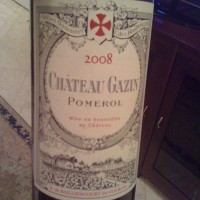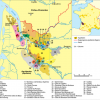As stated in my previous article on Bordeaux, I was invited to sample a friend’s 2008 en premier right and left bank purchases. This is the first of those wines sampled that evening and reminded me of why right bank, merlot heavy, Bordeaux can be so delicious. Without getting ahead of myself, I want to tell you a little about the chateau and then progress into the tasting.
Located on the renowned sand and gravel with a clay subsoil plateau of Pomerol, the vineyards of Château GAZIN cover 64.2 acres in a single lot (56.8 acres under vines), which is large for Pomerol. This area has a well known and respected viticultural history, with the famed Petrus sharing one of Gazin’s borders. Interestingly enough, in 1969 Gazin found themselves in a financial pinch and sold 12.5 acres to Petrus. Although the sale helped to keep Gazin open, some say the loss of those vines reduced the quality of their wine.
The vines, averaging 30 years old, are planted to a density of 5,500 to 6,000 vines per hectare. The planting distribution is 90% Merlot, 7% Cabernet Sauvignon and 3% Cabernet Franc (Bouchet). Gazin produces up to 100,000 bottles each vintage of Bordeaux wine, 6000 bottles of Château GAZIN and 4000 bottles of“l’Hospitalet de Gazin”. Their second AOC Pomerol wine, “l’Hospitalet de Gazin”, was created in 1986 in order to reserve the best of the harvest for Château GAZIN.
The single Guyot pruned vines are handpicked and the grapes fermented in small cement vats. The wine is aged for 18 months in oak barrels (50% new) according to the Bordeaux tradition. While in cask, malolactic fermentation occurs, replacing the harsh malic acid, also found in apples, with softer lactic acid, found in milk. Fining occurs with egg whites and, if necessary, light filtration. After bottling at the château, the wine is shipped in wooden cases to the consumers worldwide. Interestingly enough, 80% of Château GAZIN production is exported.
A brief history (found on the Chateau Gazin website):
The development of the Pomerol vineyard in the 12th century up to the French Revolution of 1789 around the commandary of the Knights of St John of Jerusalem, Rhodes and Malta is confirmed by very old documents from the Great Priory of Malta in Toulouse. The present day Château GAZIN, which was once a village in the 18th century, is located on the site of the hospital built by the Knights to host the pilgrims on their way to Santiago de Compostella.
Descendants of the High Lords of Landas, whose coat of arms they bear, the Bailliencourt dit Courcols, belong to one of the oldest families in the Artois region (northern France). The nickname “Courcol” (short neck) was given to one of them by Philippe Auguste, king of France, in 1214, for a feat of arms in the battle of Bouvines. Since then it has become the family motto : “by courage a Courcol”.
It was at the beginning of the 20th century that Louis Soualle, the present owners’ great grand-father, purchased Château GAZIN, which is now lovingly cared for by his descendants. Their children represent the fifth generation of winemakers on the father’s as well as the mother’s side of the family.
Tasting Note: (WSET Format)
APPEARANCE: Clear, ruby with some rim to core variation, medium intensity
NOSE: clean (no faults), medium to medium (+) intensity, developing, aromas of ripe plum and blackberry fruit with some moist tobacco developing aromas
PALATE: dry, medium (+) acidity, medium (+) tannin, medium (+) alcohol, medium (+) body, medium intensity, blackberry fruit, a spice or clove characteristic, medium (+) length.
CONCLUSIONS: Good quality, high priced (if purchased now). I think that this wine is still extremely young and will continue to develop. The nature of the tannins, acidity, and already emerging secondary characteristics, will make this fun to revisit in a few years (5-7).
Suggested food pairings:
Red meat and Game
Chocolate desserts with black fruit



 Masters of Wine
Masters of Wine Wine and Spirits Education Trust
Wine and Spirits Education Trust